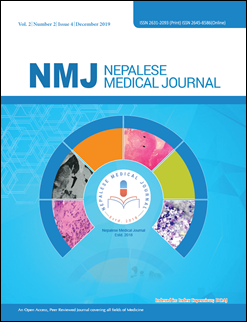Outcome of Post Esophageal Variceal Band Ligation with Sucralfate and Proton Pump Inhibitor vs. Proton Pump Inhibitor Alone in Cirrhotic Patients
DOI:
https://doi.org/10.3126/nmj.v2i2.24930Keywords:
Band ligation; Band Ulcer; Esophageal varices; Proton pump inhibitors; SucralfateAbstract
Introduction: Endoscopic band ligation is the mainstay of treatment in bleeding varices in cirrhosis. Subsequent bleeding from the band ulcers is a possible complication. Proton pump inhibitors and Sucralfate are commonly used post band ligation and often in combination. The aim of the study was to identify the advantage of combining Sucralfate to proton pump inhibitor in reducing the number and size of band ulcers.
Materials and Methods: This was an open-label comparative study conducted in a tertiary level hospital of Nepal. Patients with cirrhosis after band ligation were included. Eligible patients were randomized into a proton pump inhibitor alone (Group A) or proton pump inhibitor and sucralfate group (Group B) and they underwent upper gastrointestinal endoscopy after two weeks. Baseline parameters, number and mean size of band ulcers were compared.
Results: A total of 58 patients, 29 in each group, were evaluated. The baseline characteristics were comparable. EBL was done for bleeding varices in 51.7% and as primary prophylaxis in the rest of them. All the patients had band ulcers after two weeks. The mean size of the largest ulcer was 1.62±0.72 and 1.10±0.60 (p=0.78) respectively in groups A and B. Low albumin was significantly associated with OR of 8.7 (95% CI:1.68-44.99) for the formation of multiple (more than two) ulcers (p=0.01).
Conclusions: The ulcer formation was universal after band application. The addition of sucralfate did not offer more benefits in terms of the number and mean size of the ulcer. Low albumin was the independent predictor for multiple ulcer formation.
Downloads
Downloads
Published
How to Cite
Issue
Section
License
This license enables reusers to distribute, remix, adapt, and build upon the material in any medium or format, so long as attribution is given to the creator. The license allows for commercial use.
Copyright on any article published by Nepalese Medical Journal is retained by the author(s).
Authors grant Nepalese Medical Journal a license to publish the article and identify itself as the original publisher.
Authors also grant any third party the right to use the article freely as long as its integrity is maintained and its original authors, citation details and publisher are identified.




